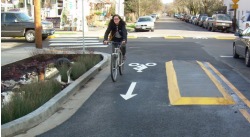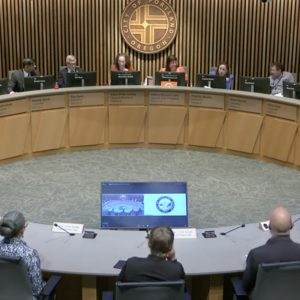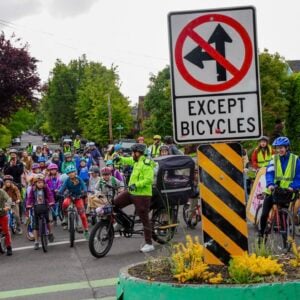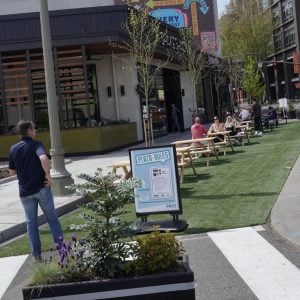
(Photo: PBOT)
Portland City Council has voted in unanimous support of Mayor Sam Adams’ proposal to use $20 million from the Bureau of Environmental Services budget for construction of bike boulevard features that are consistent with the City’s Green Streets program.
Commissioner Amanda Fritz said she was sold on the connection between green streets and stormwater/ sewer management. She reiterated many of the points I reported on earlier today and added, “It’s cheaper to manage stormwater through green streets methods than to build bigger pipes.” She added that green streets “look better” in neighborhoods, manage stormwater better, and are “more likely to result in safe streets for both pedestrians and bicyclists.” “I believe that this is using sewer money appropriately and that it’s the best thing to do.”
Commissioner Nick Fish commended the “artfulness of the mayor’s proposal” and said he had three conditions on his yes vote: That it doesn’t raise sewer rates, that they projects address stormwater, and that the projects are spread throughout the city.
Commissioner Randy Leonard spoke to how this issue has been “misrepresented in the community” and called it a “thoughtful approach to a very complex problem.”
Adams, who was behind both this plan and the City’s Green Streets policy that was adopted back in 2007 (while he was Transportation Commissioner), said spending $20 million from BES’s budget is “absolutely consistent” with city policy.
In response to today’s vote, Gerik Kransky, advocacy campaign manager with the Bicycle Transportation Alliance, said, “We’re in the middle of a recession, and this is exactly what we should be doing… investing in projects with mutual benefits.”
From here, BES and PBOT will work together to develop a list of projects to be implemented within the next year. Staffing and funding for those projects will be included in the upcoming budget.






Thanks for reading.
BikePortland has served this community with independent community journalism since 2005. We rely on subscriptions from readers like you to survive. Your financial support is vital in keeping this valuable resource alive and well.
Please subscribe today to strengthen and expand our work.
Looking forward to trying those green streets out…
Thanks!
Commissioner Nick Fish three conditions are reasonable and should help the green streets program and the bike aspects of the project.
Ensuring the project does not raise sewer rates reduces the “bikes are raising are taxes” argument often cited in public debate against bicycle projects.
Ensuring the project addresses storm water reduces the likelihood of a legal challenge to using sewer funds to pay for street improvements.
Ensuring the projects are spread throughout the city helps improve both storm water control and bike ways throughout the city rather than just the downtown core.
Looks like Taylor from PBOT in the pic!
Jonathan and BP,
Excellent coverage of this topic. Thanks for being the one media outlet that provides substantive information.
The O & WW seem to think that offering editorialized opinion pieces is the best option for informing the public on an issue.
You guys act like journalists, reporting and clearly noting what your opinion is and what the facts are. Cheers to new media and cheers to Bike Portland.
Is any of this money going to replace the wheel buckling, neck breaking drains that often take up 90% of the width of most city bike lanes?
@ Andy –
BikePortland is awesome, yes. I see you left out the Portland Mercury in your list of news outlets and they also have wonderful coverage of bike issues.
Cheers to all of us in the cycling community for uniting under the BTA-inspired Build It! campaign. When we work together we get results. Before Build It! The Bike Plan included no money. Thanks as well to Commissioner Saltzman for his leadership in initiating the funding conversation and to Mayor Adams for the follow through. Let’s keep it going.
Hopefully someone explains to the general public that politics is not just about contentious arguments and compromises, sometimes two seemingly disparate groups can cooporate to achieve their goals and STILL save tax payer money.
Sometimes you do have to spend to save.
super pumped to see this pass through. I really appreciate the effort to report the facts around the issue.
I would also like to tip my helmet to the community for rallying around the build it campaign. It’s nice to live in a city that looks at funding things they pass. Fritz gets kudos for laying out the dollars and sense ( correctly spelled) of NOT returning about a dollar to each tax payer, which would have cost about 50 cents to mail out, but instead using it to create a livable future with tangible facts on the ground projects.
“It’s cheaper to manage stormwater through green streets methods than to build bigger pipes.”
Which shows just how profoundly Fritz (and several others, apparently) misunderstand stormwater management. In short–it doesn’t work that way. The choice isn’t between “pipes” and “swales”.
Let me clue you in, readers: If you were to build “green streets” on *every single major thoroughfare in Portland*, the amound of stormwater it’d manage would be minimal. Yes, minimal.
These green street designs are boutique efforts, with minimal results. They *look* good, but the bulk of stormwater in urban environments isn’t just streets, it’s the built environment itself–buildings, parking lots, sidewalks, large streets, runoff from construction, and so on. In other words, the denser the city becomes, the more it becomes impossible to reconfigure the deflector dish to move water around like a carnival ride–and treat it. It’s such a critical problem that City Council’s decision is like a middle school science class trying to launch an Apollo mission.
Those paved roads you bike on? Your bike and autos (and the road itself) create contaminants. “green streets” only deal with a tiny, tiny fraction of those contaminants–and they’ve been proven to be largely ineffective.
There’s a lot more. But hey–go ahead, and cheer this as some sort of innovative, insightful solution. In truth, it’s not. The lie you’re swallowing whole, and the faith you place in a City Council that’s so arrogant that it doesn’t even understand the issues it’s slinging millions of your dollars at, will be a sad epitaph in a few decades.
Ride on.
Or, if that was too complicated for you, try this simile instead: City Council’s recent attempt is like trying to solve diarrhea by making the toilet deeper and wider.
“There’s a lot more. But hey–go ahead, and cheer this as some sort of innovative, insightful solution. In truth, it’s not.”
Interesting how your entire post is nothing but unsupported opinion masquerading as fact. This might work at bojack.org, where dissenting views are deleted, but you are actually going to have to back up your assertions here.
When properly implemented bioswales are 1 for 1 replacement for storm drains which funnel water from “buildings, parking lots, sidewalks, large streets” directly into the sewage system.
And Portland is a national leader in the implementation of this strategy to mitigate accumulation of environmental contaminants in sewage effluent:
http://www.portlandonline.com/bes/index.cfm?a=62886&c=51709
“Those paved roads you bike on? Your bike and autos (and the road itself) create contaminants. “green streets” only deal with a tiny, tiny fraction of those contaminants–and they’ve been proven to be largely ineffective.”
Actually, paved streets alone comprise approx 40% of the city of Portland’s built environment.
I’m intrigued by eco’s insinuations, but like spare_wheel i’m going to need more info. If what BES is doing is a sham – and they’re building bioswales left & right here in inner SE – why isn’t anyone else questioning their efficacy? or maybe they are and i haven’t noticed?
Glad the funding passed Council, but either the media was completely disingenuous about the logical connexion in their coverage (the Mirk-Merc excepted), or someone(s) with the Mayor’s office and/or PBoT didn’t do an especially good job making the nexus apparent. Water under the bridge (or in the bioswale, rather) and all that, but there’s a lesson here.
Interesting how your entire post is nothing but unsupported opinion masquerading as fact.
Oddly, that’s exactly what most of your response was.
This might work at bojack.org
Which, of course, has nothing to do with the topic at hand. But something tells me you have an agenda of your own.
When properly implemented bioswales are 1 for 1 replacement for storm drains which funnel water from “buildings, parking lots, sidewalks, large streets” directly into the sewage system.
Bioswales and storm drains don’t perform the same function, smart guy. A storm drain is a conveyance, a bioswale is a treatment practice. And when a green street bioswale is overloaded–it drains into a storm drain. Never mind the ongoing maintenance and re-building necessary to make them actually perform.
The problem isn’t enough “storm drains” or enough bioswales. And, I’d challenge you to offer credible proof that a bioswale–implemented as part of a “green street”–actually mitigates a meaningful percentage of stormwater runoff from a pevious site. Proof, not something regurgitated from City Hall.
And Portland is a national leader in the implementation of this strategy to mitigate accumulation of environmental contaminants in sewage effluent:
How would you quantify “national leader”, exactly? And what does that have to do with the strategy being effective? Portland’s a national leader in unemployment, property crime, and teen pregnancy, too.
And by the way, that South Waterfront development you see slowly disintegrating into disaster?
Sam Adams was one of the strongest proponents of it. He, along with Vera Katz, ridiculed critics who said the idea of “10,000 biotech jobs” and some sort of city within the city was not only ridiculous, but irresponsible.
Now, Adams is mayor, and tries to avoid the subject. Like many other subjects he tries to avoid, I notice.
Look, folks: If you don’t want to believe anything, at least pause and reflect for a moment or two on the history of decision-making in Portland. The problems that the City now spends millions on–and that Adams and Council want to spend millions on to fix–were approved, promoted, and carefully justified by PBOT, local government, and anybody with a financial stake.
In other words, be careful about how smart we think we might be about what constitutes “beneficial”. Unintended Consequences is always the largest line item in the city budget. “green streets” are a concept meant to deal with previous stupid decisions, piled wide and high upon one another. Assuming that bicycles and bioswales are somehow the Answer to some large problem might just be another item on that pile.
Actually, paved streets alone comprise approx 40% of the city of Portland’s built environment.
Didn’t read what I wrote, did you?
Where was the pic taken for this post? I don’t recognize it.
ecohuman makes some good points:
“And, I’d challenge you to offer credible proof that a bioswale–implemented as part of a “green street”–actually mitigates a meaningful percentage of stormwater runoff from a pevious site.” ecohuman
Portland DOT or someone that did consulting work for it leading towards green street bioswales probably has some studies that have arrived at a capacity figure for water/sq feet of pavement.
I don’t know how valid the claim that Portland is as spare_wheel offers:
“… a national leader in the implementation of this strategy to mitigate accumulation of environmental contaminants in sewage effluent: …”
…but Portland is definitely doing some interesting things in an effort to deal with negative consequences of pavement runoff. One example is the the St.Mary’s School parking lot on about southwest 5th and 5th and Market. The whole thing looks to have been recently engineered to incorporate landscaping (replacing its former all stone retaining walls) in large part for the purpose of dealing with runoff.
The theory is that the dirt in the bioswales neutralizes all the contaminants from the runoff. But ‘for how long?’. What’s the long term performance of these things? I suppose we’ll have to wait and see.
I’m still not enthusiastic about the idea of using them to calm traffic in a way that squeezes a street’s traffic handling capability down.
That’s the problem with blogs as they relate to reasonable civil discourse. One jackass with a conspiracy agenda and spare time can hijack a conversation.
Well politically this is a disaster for the bike plan as a whole. Adams ham handed way of pushing this through caused significant rate payer anger. This looks to many Portlanders like a giveaway of their sewer dollars to the bike lobby.
Whether or not that is true is irrelevant. Perception is what is important. The next time funding for the bike plan is broached there is going to be a backlash. Rate payers now feel like they have already been forced to contribute to the plan. They are not going to be enamored with the idea of funding it further.
From here on getting people to sign off on any taxes/fees to support the plan is going to be a near impossible sell. Sam may not care because he already knows that he is a lame duck. Do you think other council members will really be willing to stake their positions on this in the future? Don’t bet on it.
Twenty million is peanuts, and it cost the council significant political capitol. I hope you think it was worth it.
I think it’s a shame they just tore up a bunch of decent (it seemed ok to me!) sidewalks on Denver to replace them with sidewalks with swales.
I mean, It seems to me like the green thing to do would be to leave the existing sidewalks how they are and make new developments have “green streets.”
I am sorry but i do not agree with the use of the funds for green bike way’s, We have school’s closing and kid’s being bused out of there district, teacher being let go, I could go on and on for much better use’s for the money. I think that this a touchy subject on a lot area’s.
ecohuman #[varied] – I have asked some questions about these myself and can’t get a straight answer. I speculate that the real issue isn’t the management of anything as mundane as storm-water run-off, but rather that of control.
Consider, Portland is nothing like what the vast majority of recent newcomers think it is, or expected it to be. It’s chock full of poor-whites, the last Politically Correct Big Game left in the wilderness of non-Progressive Liberalism. Which I presume must be fairly disappointing. As such treatments of this sort, and there are numerous, are nothing but lifestyle-monuments. I assert that there’s no difference between a so-called bio-swale, and a Christian Cross, other than denomination. It’s not about the environment, it’s about the argument over what we should do about the environment. So, I wouldn’t hold my breath waiting for supporters of this kind of thing to start making any sense.
Nobody, and I mean nobody, has a plan to manage saturated, contaminated, or otherwise depleted, material used in these swales. It’s as though it never occurred to anyone that these might gather and store pollutants, even though that’s the intended function. Never-mind the lab for a second, common-sense dictates that this cycle will cause a build-up of anything it filters out of storm-water that isn’t water soluble.
A regular reader here tried to answer some of my many questions about these so-called bio-swales, but my rep encroached, and they ended up behaving as though I was playing some sort of game. Unfortunate that because they seemed pretty knowledgeable. They did say the pseudo-word ‘bioremediation’ over and over again. After researching this non-word a bit I’d discover bioremediation on the scale supported by bio-swales is negligible, just as you yourself have pointed out. Moreover, the actual dirt in these, the soil itself, is fairly saturated already, as evidenced by the difficulty of fertilizing soil in agricultural environments. I wonder if folks forget that ‘saturated’ is a clinical measurement? This is a ‘state’, as it were, and in this state soil isn’t going to capture much of anything but biomass like spent tree-leaves, and human litter. They say ‘heavy-metals’ too, but fail to acknowledge the soil which will be placed in these is already fairly saturated with heavy-metals of its own so it actually adds to heavy-metal in run-off as much as it ‘might’ filter any out.
Benzene, a petroleum by-product, also produced when legumes rot, is the strongest carcinogen known to man. Benzene poses huge problems in sewage treatment therefore I assert that any attempt to treat any water on a wholesale scale will be faced with the same problem. So I am concerned about the presence of concentrated benzene eventually being present in these. Benzene is a tiny molecule and is not metabolized by any plant, or mammal. It will simply pass right through a cell-wall.
Other places where these have been used were given a different sales-pitch than the one we’re getting. The idea here was to replace the cast-iron ‘grating’ with a subjectively attractive patch of ‘natural flora’ that would presumably perform the same function. That makes a little more sense, but this then raises the issue of choosing a storm-drain-grate that costs under a hundred dollars to produce with one that costs tens of thousands. I’m reminded of the $400+ bike-racks downtown replacing the $80 ones because they, “Look better…”. Americans, typically more pragmatic about aesthetics in public infrastructure, weren’t buying so these remarkable, yet ineffectual, corollary benefits have been conflated out of all proportion. Any chemistry going on her is simply negligible and a non-issue. As I’ve stated, these aren’t being installed because the effect the corporeal environment. They’re being installed to make a political statement about any one whom opposes the Church of Green.
If these things were even capable of doing some of the magic things their supporters tout, they’d accrue pollutants. Are we just installing toxic-waste pools on our street corners because the Church of Green can’t seem to stop living our lives for us? Nobody knows. The flora in these are not all indigenous species either. Add to this now we’re introducing foreign flora to a rain-forest ecosystem so delicate we’ve got laws about that sort of thing. These aren’t sterile flora either and their exposure to toxic pollutants could negatively impact seed production; and then not only do we have non-indigenous plant species in a rain-forest ecosystem, we’ve got mutant, non-indigenous plant species in a rain-forest ecosystem.
Speaking of contaminated, non-indigenous, mutant flora, what about wild, and domestic fauna, which may consume flora in these things? Will the pollution accrued here be harmful to family pets, or wild birds and squirrels? Nobody knows, it seems these questions have ever been asked.
I stopped trying to make sense of this because it’s painfully obvious why they are being installed. This is about controlling people and their lifestyles. This is about newcomers asserting their vision of Portland. This is about putting superfluous little green-patches up as monuments to the right-ness of the terminally ignorant fools, prolific and endemic within the Church of Green, and their dogmatic mantra ‘…the sky is falling, the sky is falling…
Vance, have you ever considered starting a satirical “Church of Green?”
It would be way funny if you held mass at a bioswale, or maybe went out and blessed new bioswales as they are installed.
Vance does have some good questions; ecohuman has some assertions but doesn’t back them up with data or sources.
As a scientifically-minded person, I’d like to know the answers or at least get a chance to look at the data, read through the sources, etc.
Adlangx, #23, also has some good points about just HOW the plan was presented to the public– It absolutely looks like the City is using sewer fees for bike projects, even though that’s not where the funds came from.
The City did a crap job (ha! ha!) of getting that information out to the major media outlets– The Oregonian, and our local news affiliates KATU, KOIN, KGW.
What we’ve got now is a lot of backlash about “special interest groups” taking “our money that we paid in sewer fees” to use on projects “that only benefit a very small minority of people”.
It looks bad, it really does. All the quotes from various commissioners aren’t doing anything to mitigate the backlash– The City needs to present a line-item document to the Oregonian and the news media that outlines very clearly just where the money is coming from. That MIGHT help, a little bit… but I doubt it– people get entrenched in their ideas and damn logic or facts.
Ecohuman,
I think the onus is on *you* to defend the unsupported claims you made in your drive-by post. And thanks for validating my impression of you as a bojackian grump by the *off topic* ranting about sowa.
“Bioswales and storm drains don’t perform the same function, smart guy. A storm drain is a conveyance, a bioswale is a treatment practice.”
Risable semantic parsing. I suppose capturing storm water effluent is not a *function*.
I provided a link that documents the dozens of bioswale projects in PDX. These include one of the largest projects in the nation along the Willamette river park/trail.
Here is another large project that covers the entirety of the OMSI parking area: http://www.portlandonline.com/bes/index.cfm?a=78489&c=45388
If ecohuman cannot back up his claims they are by definition “not good”. Once he does I promise to post links to data assessing the effectiveness of bioswales in removing environmental contaminants.
“Benzene, a petroleum by-product, also produced when legumes rot, is the strongest carcinogen known to man.”
Vance, FYI I have compounds sitting on shelves in my lab that are orders of magnitude more carcinogenic than benzene. And its not like no one has though about what to do with accumlated contaminants — there is a literature on contaminant treatment/degradation. For example, benzene is readily degraded by anaerobic bacteria.
I provided a link that documents the dozens of bioswale projects in PDX. These include one of the largest projects in the nation along the Willamette river park/trail.
Which, again, for the third tim, does not “prove” or “back up” the efficacy or actual claims of usefulness about bioswales in PDX. It also doesn’t explain at all the financial shell game that’s being done to build them.
Risable semantic parsing. I suppose capturing storm water effluent is not a *function*.
Speaking of semantics, It’s painfully clear that when it serves you, you rely heavily on them. Bioswales are a typical *small scale* best management practice, with a lot of implications, limits, and arguable applicability. Storm drains perform only one function–transporting runoff to a drainage system. You don’t put a bioswale where storm drain would go in a pervious area, necessarily–you put *both* there.
I think the onus is on *you* to defend the unsupported claims you made in your drive-by post.
Feel free to think that. But, okay; now I get it. If someone disagrees with you, it’s a “drive by post”. If somebody has an informed opinion that you don’t like, it’s an “unsupported claim”. If you reject that person’s claim without providing meaningful quantitative evidence yourself, that’s “good”.
And thanks for validating my impression of you as a bojackian grump by the *off topic* ranting about sowa.
And thanks for validating my impression of you as somebody who spends a lot of time attacking people instead of concepts. Never mind the irony of pointing out something as “off topic”.
And its not like no one has though about what to do with accumlated contaminants — there is a literature on contaminant treatment/degradation. For example, benzene is readily degraded by anaerobic bacteria.
While you’re off in the corner nipping at the corners of the issue–and carefully so, it seems–the larger issue remains unaddressed. City Council’s doing something fiscally and ethically wrong here, and using questionable “science” to justify it. Based on my own experience and knowledge, they’re either grossly misinformed, or grossly arrogant, or perhaps both. In other words, this is a political move, and nothing more. Let those that have eyes to see it, see it.
ecohuman sez
“City Council’s doing something fiscally and ethically wrong here, and using questionable “science” to justify it. Based on my own experience and knowledge, they’re either grossly misinformed, or grossly arrogant, or perhaps both.”
This is my impression. These bioswales seem to have a novelty factor to them. Otherwise we would go ahead and put them on every corner, right?
I mean, if bioswales are “worth it” then every time you put one uphill of a storm drain it would be a win. So why not put one in front of every storm drain in town? We’re not going to see that, because they probably aren’t “worth it” in the long run.
I tend to think these have more symbolic value than environmental value, but since my opinion is in the minority I’m sure that the onus for proof is my responsibility… so feel free to ignore my impression!
Swales actually do work pretty effectively. We’ve had them in Washington County for quite some time, now. On the other hand, the swales we have are BIG. Not these curb-extension knuckles in the middle of an intersection, usually an entire lot.
The PURB laid the wood to the council on this.
http://www.oregonlive.com/portland/index.ssf/2010/03/purb_slams_portland_city_counc.html
I’m sure that the council will ignore their recommendations, but this just compounds the horrible PR that the bike plan has gotten during the process.
Adams and the council could not have handled this any worse.
From Frits’ Blog
“I don’t know if having the information about ongoing rate impacts would have changed my vote, if I had received it earlier.”
Apparently it’s not .90 per ratepayer… because it’s borrowed money it’s more like $65 over 25 years.
Whoops!